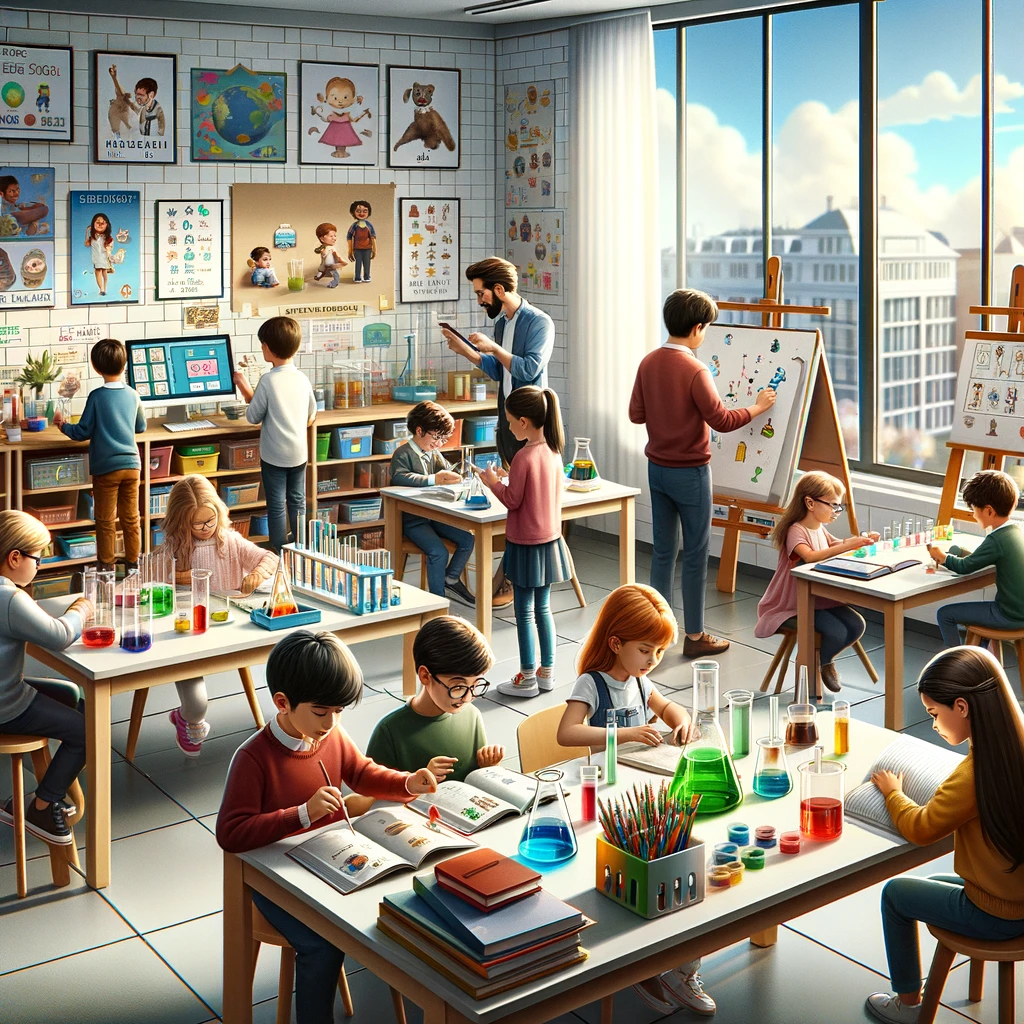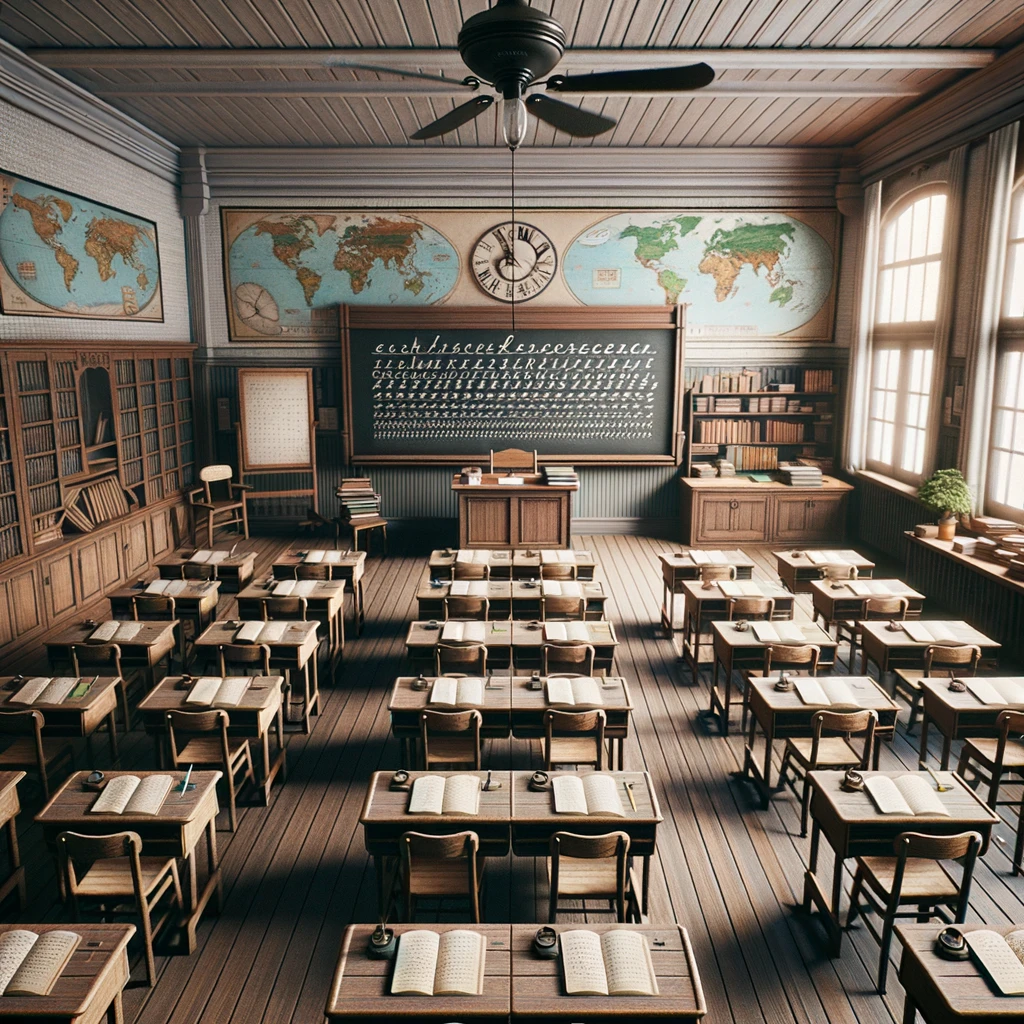Ending One Size Fits All Education with DKR
Education stands as one of the few domains that has been resistant to deep, structural change. Maybe we can change this with DKR.

Education stands as one of the few domains that has been resistant to deep, structural change. Even as technology advances at an unprecedented pace, the core methodology of education remains steadfast, a relic of a bygone era modelled on industrial efficiency rather than individual growth. But what if a transformative approach could disrupt this status quo, tailor education to individual needs, and thus usher in a new epoch of learning? Welcome to the groundbreaking world of Dynamic Knowledge Rendering (DKR), a technology-driven, personalised learning paradigm that aims to redefine the educational landscape for students and teachers alike.
For decades, perhaps even centuries, the basic structure of education has remained largely unchanged. Classrooms still feature rows of desks facing a chalkboard or whiteboard, where a teacher stands and delivers a lesson to a group of students. The traditional model has been designed around the idea of a "one-size-fits-all" approach, offering a standardised curriculum that does not necessarily cater to individual learning styles or paces.

Historically, the rigidity of this system can be traced back to the industrial age, where education was modelled to resemble factory lines. Students are treated almost like products on an assembly line, each receiving the same information in the same manner, with little consideration for individual learning needs. This methodology prioritises uniformity and efficiency over creativity and individual growth.
While some advancements have been made in terms of teaching methods, such as the incorporation of technology and a slight shift towards student-centric approaches, these changes are often superficial. For instance, replacing chalkboards with interactive smart boards is a technological upgrade but does not inherently change the way education is delivered or consumed. The fundamental delivery system - a single teacher lecturing to a group of students - remains static. Even with updated textbooks and more relevant course material, the structural limitations of the current educational model continue to inhibit personalised learning experiences.
In a traditional classroom setting, there are often limited resources and time to provide individualised support to students. Teachers, no matter how skilled, find it challenging to cater to the specific needs of each student within the constraints of a standardised curriculum and timetable. This makes it even more difficult to address the unique challenges some students may face, whether it's a learning disability, language barrier, or simply a different way of understanding new concepts.
The limitations of the "one size fits all" approach become even more apparent as we consider the wide array of skills that students need to develop to succeed in the modern world. While a standardised system might be easier to administer, it doesn't necessarily prepare students for the complexities of life outside of school, including the need for critical thinking, adaptability, and emotional intelligence.
Moreover, the diversity in learning speeds and styles means that each student's educational journey is highly personal and unique. What may take one student a week to grasp could take another just a day, and vice versa. A system that doesn't account for these differences misses the opportunity for more students to excel.
Welcome to DKR
Dynamic Knowledge Rendering (DKR) represents a transformative approach to education, leveraging advanced technologies to create a more personalised learning experience. It goes beyond simple data collection or digital textbooks, encompassing a broad range of tools and methods to dynamically adapt the learning environment to each student's unique needs, skills, and preferences.
In terms of pace, DKR allows for real-time adjustments to the curriculum. This means if a student grasps a concept quickly, they can move on to more advanced material without waiting for the rest of the class. On the other hand, if a student is struggling, DKR can adapt the material to revisit concepts or offer additional exercises ensuring that the learner is not left behind.
DKR can also provide an unprecedented level of adaptability to individual learning styles. For example, if a student is an auditory learner, the DKR system could offer podcasts or verbal explanations. For a visual learner, it might present more infographics, videos, or graphical simulations. This ensures that the learning material resonates with the student, increasing engagement and retention. Taking into account also the time of day, optimising the information delivery to the students needs. Sometimg physical for that post lunch lesson or deep work for the earlier riser.

DKR enables continuous, formative assessment, offering immediate feedback to students and educators alike. This constant feedback loop allows the system to further refine its understanding of a student's learning style, making real-time adjustments to both teaching methods and materials. It also gives teachers valuable insights into each student's progress and areas for improvement, allowing them to tailor their instruction more effectively.
For Younger Years
DKR holds immense potential for younger learners, particularly because it allows educators to create immersive learning environments that can serve as entire universes for the students to exist within.
Take the example of learning about dinosaurs, a topic that many young students find fascinating. In a traditional classroom setting, this might involve reading a textbook or listening to a teacher's lecture. In contrast, DKR could enable educators to design a rich, interactive universe where students can learn through a mixture of guided exploration, challenges, and quests which they can experience through the method they will best absorb knowledge through.
The virtual universe might contain diverse terrains that represent the Earth as it was during various geological epochs. Students could explore these different settings to learn about plate tectonics, climate, and the geography of the prehistoric world. This could be coupled with lessons on evolution, as students observe how different species adapt to their environments.
Te DKR universe can also include elements of history and social studies. Children could learn about the scientists who made significant contributions to palaeontology or virtually participate in a dig to unearth fossils, thereby learning about the methods and tools that scientists use in their research.
What makes DKR so powerful for younger students is its ability to engage their natural sense of curiosity and play, it isn't all about technology! Lessons become adventures, and education becomes a process of discovery. Children are more likely to engage with the material, not just because it's "fun," but because it speaks to their innate desire to explore and understand the world around them.
By integrating subjects into a cohesive, interactive universe, DKR provides a multidimensional educational experience that can adapt in real-time to a young learner's needs and interests. It's a shift from passive to active learning, from memorisation to experience, and from standardisation to personalisation. With such an approach, children aren't just taught facts; they're given the tools to become lifelong learners.
Older Learners
For older students, the application of Dynamic Knowledge Rendering (DKR) can be transformative in a different way than for their younger counterparts. Older students, who are often on the cusp of higher education or entering the workforce, have more specialised educational needs. They might be zeroing in on particular subjects they excel at or enjoy, and may also be balancing a range of other commitments and pressures, such as part-time jobs or the social dynamics of the teenage years. A DKR environment tailored around these older students can offer a level of customisation and flexibility that's highly beneficial for them.
Firstly, the DKR system can adapt to the individual's learning style to an even more nuanced degree. For example, if an older student excels in independent research but struggles with timed, high-pressure exams, the system could provide more opportunities for project-based assessment rather than traditional exams or be utilised to make exams less fearful with daily practice in a different modality such as the stress of a computer game.
DKR can support older students in exploring subjects at a much deeper level. Let's say a student has a strong interest in environmental science; the DKR environment can adapt to provide advanced resources, real-world case studies, and even virtual internships related to that field. It could even connect them with digital doppelganger experts in the sector for virtual Q&As, enriching their educational experience far beyond what a traditional classroom could offer.
DKR's real-time adaptability also plays a significant role in stress management, an issue that becomes increasingly relevant as students get older and face more pressure. If the system detects signs of stress or disengagement, it can adapt the learning environment to help the student cope better. This might mean suggesting a short break, offering stress management tips, or providing easier tasks for a short period to help regain confidence.
For students preparing for specific exams or planning to enter particular careers, DKR can provide targeted training and resources. Imagine a system that knows you're preparing for a medical school entrance exam and adjusts your biology and chemistry lessons to focus on the requirements for the exam.
In essence, for older students, DKR offers an educational environment that is not only responsive but also proactive, it's like having the best personal tutor right next to you. It anticipates their academic needs, accommodates their learning styles, and even adjusts to their emotional states, setting them up for a more engaging, effective, and enjoyable learning experience. It's an approach that prepares them for the challenges and opportunities they will face in higher education and beyond.
Changing the teacher role
In a world transformed by Dynamic Knowledge Rendering (DKR), the role of the teacher undergoes a significant shift. Rather than being the primary source of knowledge, educators become facilitators and guides in a more student-centric learning environment.
Teachers will oversee the DKR environment and help students navigate their personalised learning journeys. They'll interpret the data and insights provided by the DKR system to better understand each student's unique learning style, strengths, and weaknesses. Armed with this information, teachers can guide students more effectively, suggesting specific pathways, challenges, or additional resources that could be beneficial.
As DKR takes care of much of the content delivery and assessment, teachers can focus more on the human aspects of education. They become mentors and coaches who provide emotional support and life skills training. This could involve helping students develop soft skills like communication, critical thinking, and emotional intelligence - skills that automated systems can't teach effectively currently.
With an abundance of educational resources available, the role of curating quality content becomes crucial. Teachers will work alongside the DKR system to ensure that the material students encounter is not just tailored to their learning style but is also accurate, up-to-date, and relevant. This involves selecting the best resources from an array of options and potentially even creating new resources to fill any gaps.
Teachers will still play a vital role in classroom structure and culture, establishing norms and expectations that foster a respectful, inclusive learning environment. They may also become more involved in collaborative projects, guiding students in group work that encourages teamwork, leadership, and interpersonal skills.
In essence, the adoption of DKR technologies allows teachers to transcend traditional roles and engage in a more holistic form of education. They can shift their focus from merely instructing to nurturing a range of skills and capabilities that prepare students for life beyond the classroom. While the technology handles much of the personalised content delivery and assessment, teachers remain indispensable for their expertise, empathy, and ability to inspire.
Being Mindful of Social Dynamics
While the personalisation offered by Dynamic Knowledge Rendering (DKR) can revolutionise the way students learn, it's also important to be mindful of the value that group experiences bring to social dynamics and overall education. Far from being a downside, this is an aspect that needs to be thoughtfully integrated into any educational system leaning into DKR or similar technologies.
Being part of a group teaches students essential social skills like communication, collaboration, and empathy. These skills are not just supplemental to their academic learning but are foundational life skills. Therefore, even as DKR tailors the learning journey to individual needs, it's crucial to maintain opportunities for group interactions to develop these interpersonal skills.
Moreover, managing social dynamics and conflict resolution are valuable skills often learned in group settings. These experiences help students develop emotional intelligence, the importance of which cannot be overstated. While an individualised system can offer many benefits in terms of academic growth, it's essential not to lose sight of the emotional and social growth that comes from group interactions.
How to get started
Incorporating transformative technologies like Dynamic Knowledge Rendering (DKR) into traditional educational settings is an enormous undertaking, fraught with logistical, budgetary, and cultural challenges. Traditional education systems are deeply entrenched, governed by long-standing policies, cultural norms, and societal expectations. There's also the challenge of teacher retraining, infrastructural upgrades, and perhaps most importantly, a broad ideological shift away from 'one-size-fits-all' to personalised, technology-driven education.
Countries that are already at the forefront of technological innovation and educational reform stand the best chance of effectively integrating systems like DKR. Emerging smart cities—designed with technology integrated into their very fabric—offer an unprecedented opportunity to build educational systems from the ground up, incorporating advanced technologies like DKR from the outset. These cities could serve as 'living laboratories' for educational reform, free from the constraints of legacy systems and traditional mindsets. Here, in environments ripe for innovation, the true potential of a technology-driven, personalised education system could be realised and refined.
Once a successful model has been established, whether in an innovative country or a newly minted smart city, it can serve as a blueprint for other nations to emulate. This isn't just about demonstrating that the technology works, but about showing that it can lead to better educational outcomes, more engaged students, and ultimately, a more skilled and adaptable humans. This evidence will be crucial for overcoming resistance to change in more traditional educational settings around the world.
